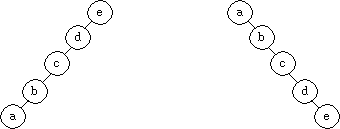Binary Tree
Before we dive into this particular question, it's nice to go over the basic concept of binary tree:
1. The relationship is between "parent" node and "children" node. Except root, every child node has an unique parent, every parent can have left/right child.
class Treenode{
int value;
Treenode left;
Treenode right;
}
2. size and height of a Tree:
size -
total # of the nodes that tree contains;
height -
the longest path from a root to its descendants.
//Recursively:
int size(Treenode *t){
if (t == nullptr)
return null;
else
return 1+size(t.left)+size(t.right)
}
//Iteratively:Using Stack to remember the root of both the left and right subtrees for each Treenode it visits in Stack
int size(Treenode *t){
int sizeOfBT = 0;
ArrayStack
The minimum height of a binary tree is :
log2(n+1)−1
3. BFS/DFS Traversal:
4. Perfect Binary Tree & Complete Binary Tree & Balanced Binary Tree:

Full Binary Tree: A binary tree is full if every node has 0 or 2 children.
Perfect Binary Tree is where:
- All leaf nodes have the same depth;
- All other(than leaf) nodes are full nodes
A recursive definition of a perfect binary tree is:
- A single node with no children is a perfect binary tree of height h=0
- A perfect Binary Tree with height h>0 is a node where both sub-trees are non-overlapping perfect binary trees of height h-1
Complete Binary Tree:
In a complete binary tree every level, except possibly the last, is completely filled, and all nodes in the last level are as far left as possible.
Degenerate Tree:
A tree where every internal node has one child. 
Well-balanced Tree:
Rather than letting them degrade to a worst-case behavior of O(n). To do that, we need to decide on a balance condition, which is to say that we need to understand what shape is considered well-enough balanced for our purposes, even if not perfect.
A "good" balance condition has two properties:
- The height of a binary search tree meeting the condition is Θ(log n).
- It takes O(log n) time to re-balance the tree on insertions and removals.